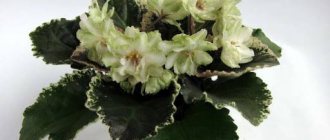Violet or Saintpaulia belongs to the herbaceous perennials of the Gesneriaceae family. It is a miniature houseplant that is highly prized by gardeners for its decorative foliage and abundant, colorful blooms that repeat several times a year.
Today, breeders have developed many hybrid varieties of violets, which amaze with the splendor of the shape and color of both flowers and foliage. Therefore, every lover of these miniature plants can create a collection of them based on their preferences.
Violet SM-Zephyr (Seedling Morev)
SM-Zephyr is one of the representatives of indoor Uzambor violets, which belong to the genus of hybrid Saintpaulias from the Gesneriev family. The seedling was bred and registered by Kostantin Morev, who has developed a few varieties, but they are all very beautiful. The breeder himself is very scrupulous about the concept of a variety, and therefore many of his offspring bear names with the notation “seedling”.
A rosette of standard type and size, which has rounded leaves on elongated cuttings. The medium green color of the leaves, which depends on the light and temperature, may darken slightly or approach a light shade.
Delicate violet Zephyr.
Important! The shape of the sheets is very recognizable; they are quilted and have a kind of ruffle along the edge. This is a feature of this variety.
The flower has the shape of a cupped star , most are single flowers, but sometimes semi-double specimens occur. The color of the flowers is quite delicate, gentle and alluring, and also often incomprehensible. In the original, the main shade is white, and in the center of the petals there are pink prints in the form of strokes. But sensitivity to temperature and light conditions changes color from white with a slight pink tint to pure hot pink.
SM-Zephyr has a sport that has curly leaves. There are various sports: photos and descriptions of which you can see on the Internet.
Features of the violet variety Zephyr
Blooming violet Zephyr is white, with many blurry soft pink strokes on the petals. The flowering itself is cup-shaped, star-shaped. Sometimes there are subspecies with semi-double flowers. The average diameter of each flower is 4 centimeters.
The flowering of Zephyr is abundant and long-lasting. This is possible thanks to the strong peduncle, which can have several buds at the same time.
When talking about this violet, one cannot fail to mention the leaves. They have a round shape with a ruffle along the edge. The color of the leaves is light green. The rosette of violet Zephyr is beautiful and neat, at the same time quite compact and strong. This violet is easily propagated by leaves. The leaves quickly take root and produce new rosettes.
Caring for a plant at home
SM-Zephyr is a slightly demanding variety, the color of which is highly dependent on temperature and lighting, which makes it slightly capricious . Otherwise, the variety is very resistant to external, unfavorable factors.
Violet requires proper care.
Place of cultivation
forms a rosette well , but in such conditions the flowers usually lighten. It is imperative, as with all Saintpaulias, to protect it from direct sunlight, because it burns the delicate leaves.
Temperature, no less than light, affects the color of the petals:
- If you create cooler conditions (it is vital to maintain the temperature at least +16°), there is a strong lightening of the colors, which sometimes brings the color to white, with barely noticeable pink prints, more like spraying;
- An increase in temperature (about 26°-28°, but not higher) darkens the color, to pure pink, sometimes even crimson.
The optimal temperature range is considered to be from 22 to 24°.
Increases and decreases in the level of moisture in the air also have a detrimental effect on flowers:
- Humidity above 70% leads to rotting of sheets and growing points;
- And a decrease below 40% dries out the substrate and sheets.
Attention! Both options lead to the death of the flower if measures are not taken in time.
Watering and fertilizing
Like all Saintpaulias, SM-Zephyr can be watered in two ways :
- Classic (in a tray or under the leaves) - about once every 7 days, water is poured into the tray (under the leaves), and 20 minutes after the procedure, the excess is drained. Mineral fertilizing is applied periodically, alternating watering - once with fertilizer, the next with clean water, and the dosage is halved;
- Wick – the cord is placed in a pot and brought out through a drainage hole, a container with water is placed under the flowerpot. There is always water in the container, and fertilizers are constantly there, and its concentration decreases by 7-8 times, relative to the instructions.
Saintpaulias are often watered using a wick.
Replanting and pruning
Before transplanting, it is important to choose soil . You can simply buy a ready-made mixture for Saintpaulia at a flower shop. When making a homemade mixture, you need to consider what type of watering is used. For the classic one, the composition includes:
- 1 part sheet soil;
- 1 part perlite;
- 1 part peat;
- 0.5 parts sphagnum moss.
For the wick type you need only two ingredients in equal proportions :
- Peat;
- And perlite.
Trim the bush as necessary, removing dying ones :
- Sheets;
- Peduncles;
- And during transplantation, the roots.
In addition to hygienic pruning, it is important to obtain material for vegetative propagation:
- Healthy sheets 2-3 rows;
- Blooming flower stalks;
- Stepsons.
Transplantation is a necessity for healthy flower growth; it is carried out :
- To increase the size of the flowerpot - as the young bush grows, it needs more and more space;
- Replacing unsuitable soil - the substrate is gradually depleted and requires regular replacement, which is carried out 1-2 times a year;
- In case of illness , the transplant is carried out as in the previous case, but the flowerpot and plant are additionally processed, sometimes the size of the pot has to be reduced.
Reproduction
This variety reproduces well by any convenient method :
- Leaf cuttings – sheets of the second and third rows are rooted in soil, water or moss. Sheets consistently produce several children;
Saintpaulia is propagated by leaves. - Stepchildren - grown stepsons are separated and planted (provided they have their own roots), or rooted as leaf cuttings;
- Peduncles - not completely wilted peduncles are rooted in the soil under the film.
Conditions for care and maintenance of the variety
Although violets are considered finicky plants, caring for them is not particularly difficult. In order to get healthy and abundantly blooming rosettes, you just need to study the rules for maintaining these flowers and carefully follow them.
Placement
For the Zephyr violet, you need to choose a well-lit place, but without direct sunlight. If this is not possible, then you need to create additional shelter for the plant during a particularly hot period. For the harmonious development of these colors, the eastern or western side of the room is well suited.
If the Zephyr violet is placed on a northern windowsill, then its flowers will be quite small and pale, and the rosette will be weak. In this regard, the plant loses its decorative properties.
Important! It is necessary to ensure that during the growing season the violet is well lit for at least 16 hours. If this is not possible, it needs to be additionally highlighted.
Air temperature and humidity
Since the mountainous regions of Africa are considered the birthplace of violets, all of its hybrid varieties are quite heat-loving. In spring and summer they should be kept at an air temperature of 20 to 25 degrees. In winter, it is advisable to place these plants in a room with an air temperature no higher than 16 degrees. This will give the violets the opportunity to fully rest before the next flowering.
Temperature conditions are very important for violets of the Zephyr variety.
When breeding violets, the air humidity in the room should not be high, so as not to cause rotting of the rosettes. If the air is very dry, you can place containers of water around the plants or spray water indoors. The violets themselves cannot be sprayed. You also need to carry out regular ventilation, but avoid drafts.
Organization of watering
On average, the Zephyr violet is moistened no more than twice a week, after the top layer of soil has dried. The amount of watering must be adjusted depending on the air humidity in the room. If the violet is in a dormant period in a cool room in winter, then watering should be reduced to twice a month to prevent the root system from drying out.
[adsp-pro-5]
For violets during the growing season, both frequent overflows and prolonged drought are detrimental. They can lead to the development of various diseases or pest damage. For irrigation you need to use soft and warm water. Periodically, you need to clean the leaves of plants from dust using a slightly damp cloth.
Top dressing
For proper development of foliage and bright flowering, the Zephyr violet variety must be fed regularly. To do this, use complex mineral fertilizers 3 times a month during the entire growing season; in winter, fertilizing is stopped.
In order for the Zephyr violet to bloom profusely and brightly, it must be fed.
Important! After the end of the violet's dormant period, it is recommended to add organic fertilizers to the soil. It is not recommended to use them in the future, as they can provoke strong growth of green mass and inhibit the formation of buds.
Planting and replanting Zephyr violets
To obtain a powerful rosette and large, numerous buds, violets require loose, light and nutritious soil with an acidic reaction. Therefore, soil mixtures for planting these plants must include peat.
If you prepare the soil yourself, you can use the following ingredients:
- Soddy soil - 3 parts, peat - 2 parts, pine bark (crushed) - 1 part, coarse sand - 1 part.
- Leaf soil - 4 parts, peat - 3 parts, sphagnum moss - 1 part, perlite - 1 part, coarse sand - 1 part.
The prepared soil should be neutralized by calcining it in the oven and spilling it with a solution of potassium permanganate.
Indoor violets of the Zephyr variety should be replanted when there is no flowering. This could be spring or summer. To do this, you need to take a container, the volume of which will be slightly larger than the previous one, put a layer of drainage in it, and fill it with prepared soil.
Violet Zephyr must be transplanted into a new pot once a year.
The plant should be carefully removed from the pot, dried leaves and damaged roots should be cut off and placed in a new pot. If the stem at the bottom of the violet is bare, it needs to be buried in the soil. The soil around the transplanted plant should be slightly compacted and watered a little. It is recommended to place the pot in a warm, slightly shaded place until the violet takes root.
For violets, it is better to choose low bowls. Their diameter should be from 5 to 9 centimeters for young plants. In the future, you should focus on the size of the root system. It should fill the soil almost completely with small gaps near the walls. If the container is too large, then all the plant’s forces will go to root growth, and not to green mass and the formation of buds.
Reviews
Victoria. “I bought a nameless flower at the flower shop, and almost immediately got into the discussion of the SM-Zephyr seedling. She fits the description perfectly. While I was delivering it home, I beat it up a little, but I removed the damaged leaves and everything is fine, it has been blooming and feeling great for almost two weeks.
I just have doubts, please tell me an accurate description of the variety for comparison, or even better, a photo of the original.”
This Saintpaulia attracts the attention of flower growers.
Sofia. “My seedling grows well, blooms and reproduces easily. I just can’t understand why Morev didn’t recognize it as a variety, although he has a tendency that seedlings are superior to varieties in beauty.
The description of the variety is only folk. Considering that the author does not give a description of the SM-Zephyr seedling (seedlings are new violets that were rejected by the breeder for various reasons).
I believe that belonging to such violets simplifies many issues. For seedlings, a slight difference in color or shape is not considered a sport (by the way, frequent changes in color during reproduction may be a reason for rejection).”
Violet propagation Zephyr
As already mentioned at the beginning of the article, the Zephyr violet reproduces well by leaves, but this also applies to daughter rosettes. They develop quickly and form a new plant.
Reproduction by petiole. It all starts with the choice of leaves. They must be big and mature. You should not take old leaves, they take root very poorly. Cut the leaves from the bush, but carefully. The cut petiole should be at least 5 cm. The landing itself is quite easy. In a box or even a glass, add a layer of drainage (optional), soil and plant the petiole. In the case of a box, you can plant all the petioles in one. If you use cups, then you need a separate one for each leaf. After planting, the soil needs to be moistened. Place your sprouts in a warm, light place. Water as needed (the soil dries out). A signal that the plant has already established itself will be new small plants around the petioles. When they grow a little, you can transplant the violet into an individual pot.
Reproduction by rosette. This procedure is also not complicated. It is usually done during transplantation. Carefully cut off part of the leaf rosette from the main one, being careful not to damage the roots. Plant the plants in separate containers and give them a greenhouse effect; this can be done by covering them with jars. Ventilate the plants every day by removing the jars for a short time. You can remove the jars altogether after the plants have rooted.
Methods and methods of propagation of the variety
Violet Zephyr propagates very well using both leaf cuttings and daughter rosettes. They quickly take root and grow, forming beautiful, compact young plants.
Propagation by leaf cuttings
For cuttings, you need to select large and healthy leaves, carefully cut them from the bush so that the petioles are at least 5 centimeters. Then you need to take a small planting box, fill it with a layer of drainage, fill it with a nutritious soil mixture, plant the cuttings in it and moisten it.
[adsp-pro-6]
The container should be covered with polyethylene film and placed in a well-lit, warm room. Plantings need to be ventilated daily and watered as necessary. Within a month, new plants should form and grow around the cuttings. During this period, they can be seated in individual containers.
Violet Zephyr reproduces well by rooting a healthy leaf.
Important! Violet leaf cuttings can be rooted in water to which crushed activated carbon has been added. It will help prevent rotting of the planting material. After the root system has formed on them, they are transplanted into small pots.
Propagation by leaf rosettes
Propagation by leaf rosettes is a very easy and productive way to propagate violets. During transplantation, you just need to carefully cut them off from the main outlet, trying to preserve the roots.
After this, they need to be planted in separate small containers and covered with glass jars. They need to be removed daily for a short time to eliminate condensation and hydrate the plants. After rooting, they should be removed completely.
Advice from flower growers
In order for the Zephyr violet to form a beautiful, even rosette and produce abundant flowering, experienced gardeners advise using the following recommendations:
- If the violet produces pale buds, and the rosette loses its decorative appearance, it means that the room has low lighting or low air temperature. And flowers with a bright pink color indicate that the plant is too hot. It is necessary to reconsider the conditions for keeping violets.
- Violets that are constantly exposed to drafts may not form buds.
- When watering, you should not pour water into the center of the outlet, as this will cause it to rot. And if it gets on the flowers, they quickly crumble.
- Dried leaves and flower stalks should be trimmed regularly. This will prolong flowering.
- Daughter rosettes that are not planned to be used for propagation must be removed so that they do not take nutrients from the main one. You should also thin out dense foliage.
Description of the variety and its photographs
Violet Zephyr was bred by breeder K.L. Morev. The description and photo indicate that it has simple or semi-double, large, cup-shaped, star-shaped flowers with a diameter of about 4 centimeters. They have fringed white petals, which are decorated with blurry strokes of delicate pink. As it grows, the fringe begins to become more curly, and the pink spots become brighter.
This variety is characterized by quite abundant and long-lasting flowering. The plants have very strong peduncles, on which several buds can form at the same time. As a result of this, the blooming violet Zephyr becomes like a very elegant miniature bouquet.
[adsp-pro-4]
From the description of the variety it follows that Violet Zephyr has a characteristic feature. Its light green foliage resembles a piece of quilted fabric with a ruffle running along the edge. It forms an original, compact, powerful and even rosette, which is beautiful even after flowering has finished. The leaves of the Zephyr violet take root easily and produce several new rosettes, which quickly grow and begin to bloom.
Transplanting a plant
Prepare the soil before replanting. It should correspond to what was written earlier.
You can replant a violet only if it does not bloom. The best time is spring. The capacity needs to be increased, since the Zephyr violet is constantly growing. As a rule, choose a pot with a diameter three times smaller than the diameter of the rosette. Fill the new pot with drainage and the substrate you prepared earlier.
During replanting, plants are also trimmed with dead or damaged roots and leaves. Place the violet in the soil, lightly compact the soil around the stems. Water the plant and leave for some time (2-3 weeks) in a warm and dark place.
Advice from flower growers
- The variety is very beautiful and almost problem-free. The compact socket is easy to form. Cap flowering pleases almost all year round.
- The variety prefers sunlight. Lightened areas, as if from a sunburn, may appear on the shelves.
- Cutting off dried leaves and flower stalks helps the violet spend less energy, which prolongs flowering.
- Watering must be done very carefully. If water gets into the center of the socket, it can cause it to rot. When it comes into contact with flowers, it accelerates their shedding.
Thank you for your attention. I will be glad for those who share photos of their violets or just join the discussion. I look forward to your comments.
Violet Zephyr, variety description and care
Nowadays it is almost impossible to find a person who does not know what a violet is. Many flower growers incredibly value violets for their delicate foliage and abundant colorful blooms. They also love violets because most species bloom not once or twice a year, but much more often.
Today, many different varieties of violets have been bred. This variety amazes with a variety of colors, shapes and sizes. And, I am sure, everyone can find the violet that suits them best.
Possible difficulties during cultivation
With properly organized care for the Zephyr violet, there should be no difficulties with its cultivation, but you should never exclude the possibility of the appearance of some kind of illness or pest invasion.
The most common problems include:
- The appearance of powdery mildew is a disease of fungal origin. It is characterized by the accumulation of a white coating on the leaves, reminiscent of dust (difficult to erase). The reason is a combination of low temperature and high humidity in the room with the violet. For elimination, fungicidal preparations (Topaz, Saprol) are used.
- Development of fusarium - a disease that manifests itself in the form of dark spots on the petioles of a plant, which over time provoke rotting and falling of leaf blades. To save the violet, the affected parts must be removed at the first symptoms, and the remaining plant must be treated with a weak solution of potassium permanganate.
- Gray rot - a disease of fungal origin, the development of which can be explained by water getting on the leaves and petals of flowers. It appears as a fluffy gray coating, which leads to the rotting and death of the violet. To combat it, fungicidal preparations (Fundazol) are used, and in particularly difficult cases, the plant is transplanted into another pot.
Among the pests, the Zephyr violet is threatened by various types of mites, thrips, nematodes, aphids and woodlice, which can cause deformation of the leaf plates, the appearance of spots and shapeless holes on the leaves and stunting of plant growth. Systemic insecticides (Aktara, Calypso, Krutzer) are used to control pests. Heavily damaged parts of the plant will have to be removed.
The growing conditions and features of caring for the Zephyr violet are not particularly different from the requirements for the cultivation of other varieties, so both experienced and novice flower growers can cope with the task. Attention to these delicate and beautiful flowers will be fully rewarded with long and abundant flowering.
Was this article helpful?
Thank you for your opinion!
Write in the comments what questions you have not received an answer to, we will definitely respond!
You can recommend this article to your friends!











